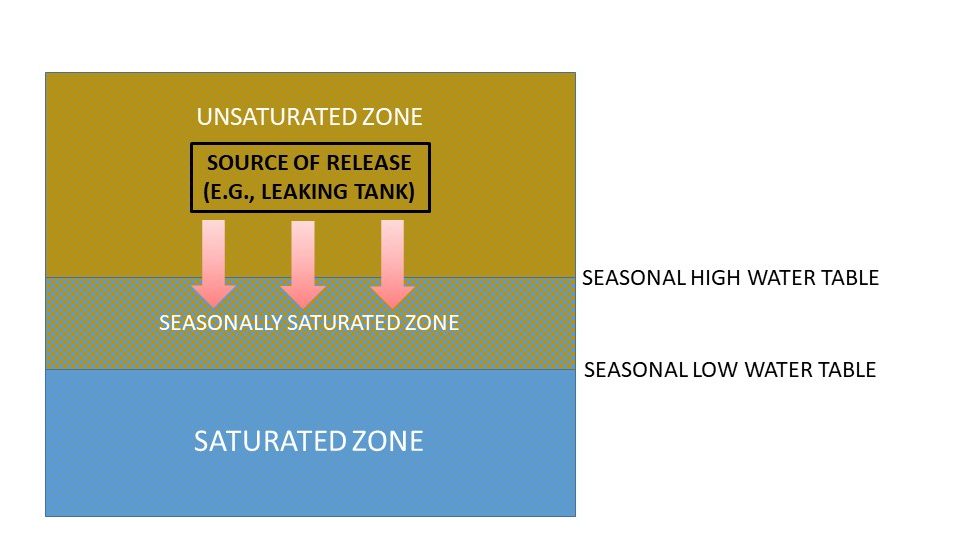PA Act 2: Characterizing the Seasonally-Saturated Zone is Critical
Selecting the Right Pennsylvania Act 2 Soil-to-Groundwater Numeric Values: Unsaturated Soils vs Seasonally Saturated Soils
From the desk of Zachary Weaver, PG, LSRP, Project Manager
Releases of regulated substances have the potential to impact soils in both the unsaturated and seasonally saturated zones. The Pennsylvania Department of Environmental Protection requires that both zones be adequately sampled and characterized to address the soil-to-groundwater pathway as part of an Act 2 or Corrective Action Process clean-up. When collecting subsurface soil samples, care must be taken to determine which zone the samples were collected from and apply the correct soil-to-groundwater numeric value to the analytical results.
Failure to apply the correct soil-to-groundwater numeric values can lead to the incomplete characterization of a site, which may cause unforeseen project delays and additional costs.
Unsaturated vs Seasonally Saturated vs Permanently Saturated Soils
When releases of regulated substances occur, these substances can travel vertically downward under the force of gravity and may result in the presence of soil contamination in three different soil zones:
- Unsaturated Zone: Zone where pore spaces are filled with air or gas (i.e. above the water table). Soil contamination in the unsaturated zone is generally small and restricted to source areas (or areas where releases originate). If a sufficient volume of regulated substances is released, it will migrate through the unsaturated zone and reach the underlying water table.
- Seasonally Saturated Zone: Zone where pore spaces are seasonally filled with water (i.e. soil zone between the seasonal high-water table and seasonal low-water table). Soil contamination in the seasonally saturated zone may be extensive depending on the severity of the release, magnitude of seasonal fluctuation, and time passed since the release.
- Permanently Saturated Zone: Zone where pore spaces are permanently filled with water (i.e. below the water table). Soil contamination in the permanently saturated zone may occur and the severity would depend on the density of the regulated substance released and site-specific geologic factors.
Often times during site characterization, only soil in the unsaturated zone is investigated and remediated, while soils in the saturated zone are either not investigated or written off by the remediator as a groundwater issue. This can be problematic for site closure because the PADEP requires remediators to select and apply the appropriate soil-to-groundwater numeric values to not only unsaturated soils, but also seasonally saturated soils. Soil contamination in permanently saturated soils under the soil-to-groundwater pathway becomes a groundwater issue and comparison to a soil-to-groundwater numeric value is not necessary; however, an assessment should be completed as contamination in the permanently saturated zone may act as a continuing source for groundwater contamination.

Selecting the Right Soil-to-Groundwater Numeric Value
The process to select the right soil-to-groundwater numeric value is as follows:
- For unsaturated soils the remediator may choose the higher of the appropriate 100 X Groundwater Medium Specific Concentration (100 X GW MSC) and the Generic Value.
- For seasonally saturated soils the selection process is similar; however, the Generic Value used in the selection process is reduced by 1/10th.
Example for two common petroleum target parameters: benzene (CAS# 71-43-2) and cumene (CAS# 98-82-8):
| Regulated Substance | Unsaturated Soil | Seasonally Saturated Soil | ||
| Used Aquifers with Total Dissolved Solids ≤2,500 in a Residential Setting | Used Aquifers with Total Dissolved Solids ≤2,500 in a Residential Setting | |||
| 100 X GW MSC | Generic Value | 100 X GW MSC | Generic Value | |
| Benzene | 0.5 | 0.13 | 0.5 | 0.013 |
| Cumene | 84 | 600 | 84 | 60 |
Notes: Values taken from 25 PA Code §250, Appendix A, Table 3, Part B, Units are in milligrams per kilogram (mg/kg)
Benzene
Soil-to-Groundwater Numeric Value for Unsaturated Soils = 0.5 mg/kg
Soil-to-Groundwater Numeric Value for Seasonally Saturated Soils = 0.5 mg/kg
Cumene
Soil-to-Groundwater Numeric Value for Unsaturated Soils = 600 mg/kg
Soil-to-Groundwater Numeric Value for Seasonally Saturated Soils = 84 mg/kg
As can be determined from the above exercise, the soil-to-groundwater numeric values for benzene are the same for unsaturated and seasonally saturated soils; however, for cumene, the soil-to-groundwater numeric value for seasonally saturated soils is lower than the soil-to-groundwater numeric value for unsaturated soils, so it is important to understand the location of your samples with respect to the seasonal fluctuation in the water table elevation and apply the correct values. Failure to apply the correct soil-to-groundwater numeric values can lead to the incomplete characterization of a site, which may cause unforeseen project delays and additional costs.